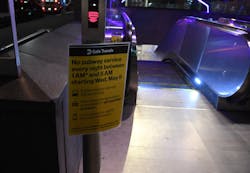During first overnight subway closure, MTA’s Essential Plan Night Service increases overnight bus ridership by 76 percent
The Metropolitan Transportation Authority (MTA) saw a 76-percent increase in overnight bus ridership under the MTA Essential Plan Night Service during the first overnight closure of the New York City subway system from 1:00-5:00 a.m.
MTA says approximately 14,500 New Yorkers traveled by bus – up from 8,300 on a recent average weekday as the MTA has enhanced overnight bus service, increasing the operational fleet by 150 percent. The overnight closure enables the largest cleaning and disinfecting program ever attempted in MTA history to protect the health and safety of all customers and employees, says the authority.
“With the debut closing of the subways completed, we're reviewing the results and will continuously monitor the system and adjust our staff deployments and local service levels in response to evolving conditions,” said MTA Chairman and CEO Patrick J. Foye. “On the first night, closure of the system enabled us to clean and disinfect every car in service and while providing alternative transportation overnight. This massive effort is designed to protect the health and safety of our customers and employees while ensuring continued transportation for the essential workforce who are heroes of this pandemic.”
“Thousands of people worked together to make this go as smoothly as possible,” said Sarah Feinberg, interim president of MTA New York City Transit. “I'm grateful to the New York City Transit workforce, to all of our cleaners, to all of the folks who work in our stations, to the NYPD, to the MTA Police, and to all of the social workers, outreach workers and nurses who came out to ensure the first temporary nighttime closure of the subway and expansion of bus service went off well.”
Bus service proves popular
In concert with increased overnight bus service, ridership on buses operating between 1:00-5:00 a.m. rose by 6,200 to 14,500. With the MTA providing the more robust overnight bus service, there were no reports of crowding on buses, says the authority.
The borough-by-borough breakdown of overnight bus ridership increases is shown below:
- Manhattan: +209 percent
- The Bronx: +98 percent
- Brooklyn: +87 percent
- Queens: +52 percent
- Staten Island: +31 percent
The MTA has significantly enhanced overnight bus service, adding 1,168 trips and 344 buses on top of the 235 that currently run during these hours. The MTA enhanced service on 61 bus lines, including 11 interborough express routes with additional stops (five routes in the Bronx, three each in Brooklyn and Queens) and 13 new routes that normally don’t offer overnight service (17 in Brooklyn, 13 in Queens, 10 each in the Bronx and Manhattan). Thirty-seven routes have added overnight service.
Cleaning
More than 700 cleaners worked last night to disinfect subway cars and deep clean subway stations. There are 2,500 cleaners working over the 24-hour period within New York City Transit. The MTA will continue to deploy additional cleaners as necessary.
To combat Covid-19, crews are enhancing cleaning of all MTA rolling stock through around the clock disinfecting, including poles, seating, floor, ceiling, doors and walls. Every car in passenger service will be disinfected at least every 24 hours.
While cleaning activities take place 24/7, the four-hour closure of the system enables crews to more effectively deep clean stations, and allows the MTA to perform additional concentrated cleaning efforts at yards and terminals overnight, where crews remove garbage and graffiti, clean spills and bio hazards, mop floors, clean seats and disinfect surfaces.
Essential Connector Service eligibility and booking details
During the first overnight closure, the MTA’s "Essential Connector” program provided 244 trips for essential employees.
Essential workers are eligible for one free trip in a for-hire vehicle per night if a bus trip would take more than 1 hour and 20 minutes or would require more than two transfers or a walk of more than a half mile to or from a bus stop.
Those who wish to use the service are asked to plan a trip at mta.info, being sure to select "bus" in travel preferences. If the bus trip falls outside the parameters above, the MTA will connect eligible users with a for-hire vehicle.
Essential workers who need to travel between 1:00-5:00 a.m. and cannot use the added bus service are encouraged to pre-book trips at mta.info/overnight.
Station security and homeless outreach
Outreach teams were deployed across the system to assist New Yorkers in need. More than 1,000 New York Police Department (NYPF) officers secured stations and helped clear trains. NYPD also focused efforts at 30 end-of-line stations.
According to the NYPD, workers and police officers made 252 contacts with New Yorkers in need; 139 of them accepted services. Shuttle buses were strategically placed throughout the system at select locations to move unsheltered New Yorkers.
